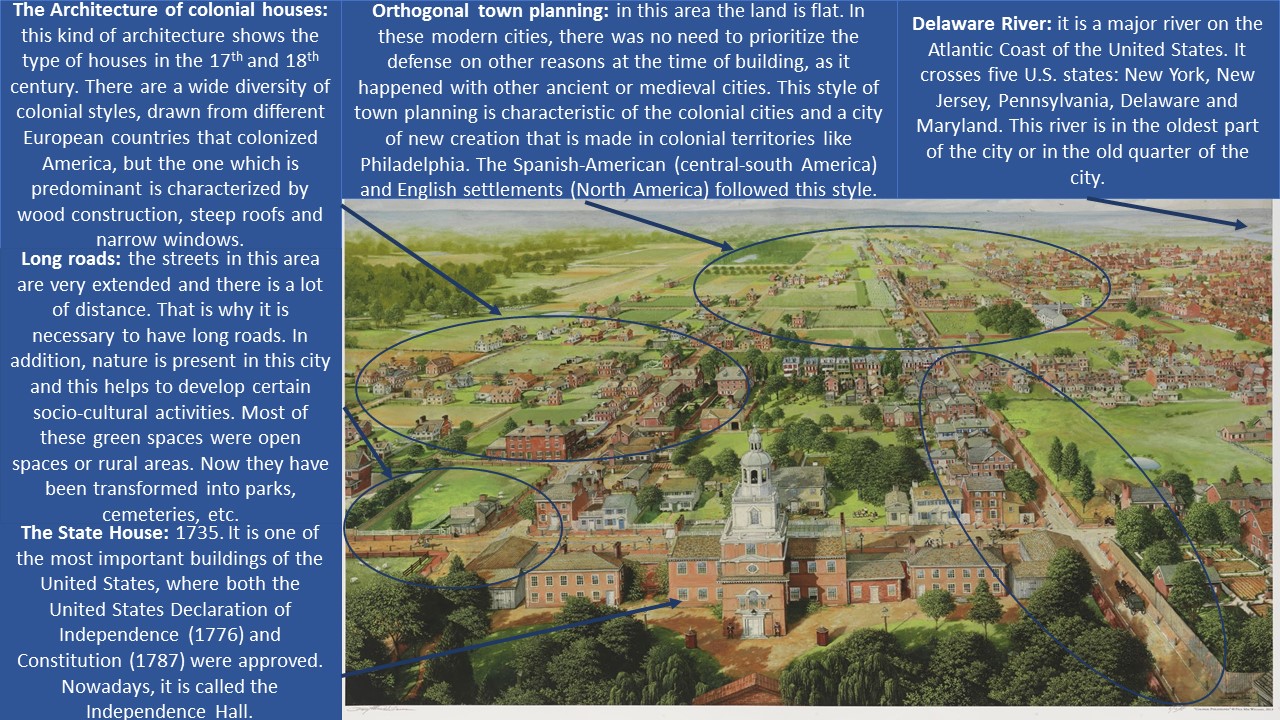PHILADELPHIA (Paul MacWilliams, 1776)
This painting is called “Pennsylvania State House in 1776”, by Paul MacWilliams, a 20th century realist painter. He has a degree in illustration from the Philadelphia College of art and he used late century 18th Philadelphia prints, maps and other visual resources to study the landscape of the city. This view shows the Independence Hall, what was called Pennsylvania State House before. The author also read a John Fanning Watson’s book named “Annals of Philadelphia” to understand better the life in the colonial city and spent a lot of hours researching at local repositories including the Library Company of Philadelphia. I have found this painting on a website of a gift shop in the state of Pennsylvania called Beauty Art, Gifts & Décor. In this shop we can also find other paintings from other painters.
The picture is an oil on linen 50×70. It depicts the artist’s research and interpretation of what the city of United States’ birth looked like in 1776, when that country declared its independence from the United Kingdom of Great Britain. Philadelphia is probably one of the most historical cities of United States.
We can find Philadelphia in the east coast of the USA and on the north American continent, next to the Atlantic Ocean. This city is also located at the confluence of the Delaware river and Schuylkill river on the eastern corner of Pennsylvania state. The Appalachian Mountains goes to the west and the Atlantic Ocean to the east. This city and this area too are usually involved by the ocean air and it brings high humidity.
The economy of Philadelphia has changed substantially throughout time. In the 17th and 18th century, this city grew as a major Atlantic seaport, receiving, processing and shipping flour, meat and forest products. Gardens were very common in the 18th century, where fruits, vegetables and herbs were grown. The farmers bought many of the other food on market day and they set up stalls to sell their wares on High Street, which is nowadays an important market in Philadelphia. Meat was also hunted in the closer woodlands.
Besides, in the early 18th century there was a great religious revival in the North American colonies. Churches came up in all shapes and sizes and they reflected the customs and traditions, as well as the social status of the denominations that built them or even the wealth of the neighborhoods.
This city presents an orthogonal town planning, because in this area the land is flat and in these modern cities, there was no need to prioritize the defense on other reasons at the time of building a city or no need of fortification, as it happened with other ancient or medieval cities. There was not either need of having defensive walls or fortifications. They first built up the streets and then built the houses and that’s why there is plenty space between one house and another. This type of town planning is characteristic of the colonial cities and a city of new creation that is made in colonial territories like Philadelphia. The Spanish-American (central-south America) and English settlements (North America) followed this style.
Philadelphia is also closely linked to nature and we can see that there are many green areas which are close to the houses. Thanks to these green areas, this city could deliver certain socio-cultural activities that favor agriculture or even livestock. We can find in the painting some farms with some cows and livestock animals inside them. Most of these green spaces in those years (18th century), were open spaces or rural areas. Nowadays, with the growth and development of Philadelphia, they have been transformed into cemeteries or even parks.
The closest area to the Delaware River can be considered as the oldest area, which is called the Old Quarter. The different areas of the city newer than those that were next to the river, were growing and extending throughout the territory over the 18th century, like the State House or the Independence Hall district. These areas are considered of new expansion and form what we now know as the modern city of Philadelphia.
In those times there was a high pressure between Great Britain and the colonists. This pressure led to Independence War. It was extended from 1775 to 1781. The first Continental Congress met in Philadelphia in 1774. The second one also met there in one year later. Then in 1776 the Declaration of Independence was written down by Thomas Jefferson in Philadelphia, 4th July. Since this day, the Americans celebrate the Independence Day of the United States. The Independence Hall, previously called The State House, was built between 1732 and 1753 by Edmund Woolley in Georgian style in this place the Declaration of Independence was written down by Thomas Jefferson in 1776. The Georgian style is characterized by its square and symmetrical shapes, central doors and straight lines of windows on the first and second floor.
On 26 September 1777 during the Independence War British troops occupied Philadelphia. However, they did not hold it for long. The British withdrew from Philadelphia on 18th June 1778. The Constitutional Convention was held in Philadelphia in 1787. The First United States Bank was built in 1797 in Philadelphia.
Alejandra Echevarría Esteban

